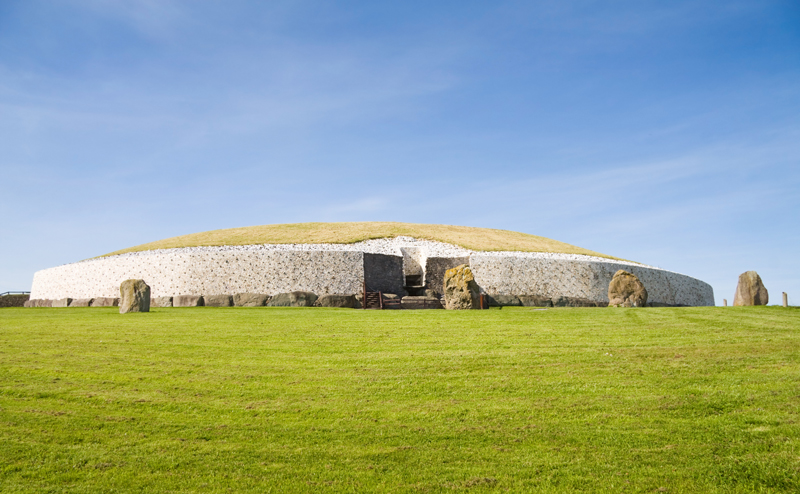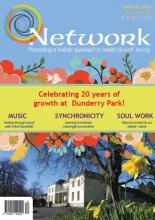Newgrange Calling

Imagine a group traveling down the River Boyne long ago to be at Newgrange for the Winter Solstice. Up to recently we could only speculate about what they would see when they arrived. But in the last two years, the earth has revealed what they would see - a landscape filled with people and buildings of all kinds, including a huge feasting hall down by the river, an enormous ceremonial passageway (cursus) running alongside the mound at Newgrange, a massive wooden henge, numerous small mounds, huts, pits, banks, ditches and wooden circles; and further downriver, a large mound like Newgrange that hadn’t been known about until the Summer of 2017. All of these add up to a rich and complex ceremonial landscape, something that many of us who have visited Newgrange have intuitively known. Four investigations in 2 years tell us so much.
Dowth House: Dowth House, as the name suggests, is just beside the mound at Dowth and is a classic ‘Big House’. When it was bought by an agri-technology company – Devenish - they commissioned an excavation which made an extraordinary find: underneath the house at Dowth was a full-size mound, half the size of Newgrange, with wonderful stone carvings and inner chambers. Excavations are still ongoing, but when I visited the site last Summer I was awestruck by the beauty of the carvings – and also by the lovely blue colour of the newly exposed greywacke stones. We’re used to the weather-beaten appearance of the carvings on the stones at Knowth and Newgrange; seeing the fresh carvings was wonderful. Overall the finding of such a large mound will radically enrich our appreciation of the Boyne Valley culture.
Newgrange Farm: Anyone wishing to drive directly to Newgrange will find it by following the signs to Newgrange Farm, which sits just below the hilltop on which Newgrange is built. When a geophysical survey revealed a sizeable 45 meter wide rectilinear structure that extended over 100 meters in length, excavations began. They revealed double rows of very large post-holes, indicating that a massive rectangular hall with wooden walls stood there around 2500 BCE. At a talk by Geraldine Stout, she expressed her excitement at another key finding – a large stone-lined pit at one end that contained charred remains of cattle and possibly sheep, evidence that this may have been a huge feasting hall.
Dronehenge: The Summer of 2018 was marked by one of the longest draughts for decades. The earth dried up and drew back, and this process revealed the outlines of many archaeological structures around the country. Perhaps the most dramatic was the clear outline of a huge circle very near to Newgrange itself, discovered by Anthony Murphy and Ken Williams using drone photography. They found the unmistakeable outline of a henge (wooden circle) that is 154 meters in diameter just beside the mound of Newgrange. Anthony Murphy describes the discovery and remarkable features of this monument in his book Dronehenge, which includes a vivid reconstruction of the henge.
UNESCO survey: According to currently available accounts, an aerial survey of the Boyne Valley, prompted by the drone footage from Anthony Murphy and Ken Williams, revealed around 40 previously unknown monuments that range in age from early Neolithic to bronze age, as well as some early medieval structures. Many of these were ceremonial and include an inner and out four-poster enclosure, what the authors call a ‘spectacular’ palisade, several different kinds of henges and many other unusual and dramatic features. The archaeologists note that the structures revealed by draught conditions as well as by new technology (geophysical imaging system) will have a huge impact on our understanding of the U-shaped bend in the Boyne where Newgrange, Kowth and Dowth – and, we now know, dozens of other structures - are located.
It is surely amazing that so much has been revealed about Newgrange and the other monuments in the Bend of the Boyne all at the same time and in such a short timeframe. In a 12-month period, a whole new cairn, a feasting hall, a huge henge, a cursus and multiple other structures have all emerged through very different pathways. Maybe Brú na Bóinne is calling us to re-imagine what happened at Newgrange, to fully express awe and wonder at the amazing accomplishments of our ancestors.
I hope to honour their culture and make the link between past and present through creative writing. My novel (Winter Sun) imagines a group of young people carrying their birth-stones to Newgrange for the Winter Solstice gathering back in Neolithic times (the Stone Age). Below are extracts from a short story (published in the first Irish Anthology of Celtic Shamanism - Soul Seers) in which I imagine a Spirit who lives across time arriving at Newgrange, firstly back at the time when Newgrange was alive as a ceremonial centre, and then today, when people still gather at Newgrange for the Winter Solstice.
I remember that time, thousands of years ago, when we travelled down the river on our raft, the wide slow flow wafting us gently along. The river started to catch currents and ripples, a soft breeze rustled through the trees, the reeds and water plants swayed with the currents. Suddenly we heard the sound of strong wings beating, and a flock of swans rose in the air, spiralling up in unison and veering over to the left. As we followed their flight our eyes were hit by dazzling white light. We had an unexpected glimpse of an enormous green mound covered in white stones rising above the top of the trees. I can see the temple to this day, its huge round shape covered by emerald green grass rising up higher than a forest, the cover of white reaching up from the grey stones laid around its base, the big curved entrance porch, the beautiful spiral carvings on the huge stone lying in front of the entrance.
And now, today, we reach the capstone on the roof of the chamber just in time for the moment of sunrise. Darkness shifts to grey, the stones loom, circles, spirals and lozenges dance. A slow shuffle of footsteps approaches. The chamber fills with humans. I can barely see their auras in the dim light. There is silence, stillness, a glimmer of orange. I fold into a stone. Shimmering gold light fills the chamber and a pulse charges through my form like lightning. A thrill courses through me, becoming hotter and hotter until I tremble with joy.
The light fades and we prepare to return to the Sídhe. For an instant I wonder if I could stay here for longer. Is there any way to connect with humans, to charge their connection with the earth again? A portal opens. I step through.
Swirling colours of the rainbow dance in front of me, ribboning across the horizon. The sun’s glow shimmers through. Forms take shape, the auras of humans, plants, stones. They crystalize, I can see clearly. What a sight! The mound of Bru looms up beside me. Crowds of people mill around on the hill. Grass stretches in every direction, the river ripples steadily along. It’s a cold sharp morning, the orange glow of the risen sun hovers above the hill across the river, warming the standing stones that remain outside the mound, leaving a soft sheen on the white quartz.
There are people of all ages. They stand in clusters or pairs, chatting. Others move in and around, looking for someone they know, a group they can join. Several stand with their back to the white wall at the base of the mound. Some stand in a line at the beautiful entrance stone. There are a few musicians gathered around a standing stone in front of the entrance.
Our ways have not been forgotten! Humans still gather on our sacred sites, honour the four elements and the four directions, call on the spirit of earth, sea and sky, of plants and animals. I beam radiant white light into the protective ring that encloses the circle, how wonderful it feels. A beam of light connects me with a woman. She gives her name as Siobhan. Her heart is heavy, she has just lost her son. The web joins us together, Siobhan, her son, me, the ancestors.
Sources:
Ger Moane is a psychologist, writer and shamanic practitioner. She has written several short stories, a play and a novel (Winter Sun) set at the time of Newgrange 5,000 years ago, when she believes humans lived in harmony with earth, sea and sky. She has trained in shamanic counselling and groupwork and has had a practice for over 15 years.
You can contact Ger at: [email protected]
Latest Issue
Upcoming Events
-
17/04/2020 to 26/04/2020
-
18/04/2020
-
23/04/2020
-
15/05/2020 to 23/05/2020
-
16/05/2020 to 17/05/2020
Recent Articles
Article Archive
- November 2014 (1)
- January 2015 (2)
- February 2015 (2)
- April 2015 (3)
- May 2015 (4)
- June 2015 (9)
- August 2015 (5)
- October 2015 (2)
- November 2015 (1)
- January 2016 (8)

